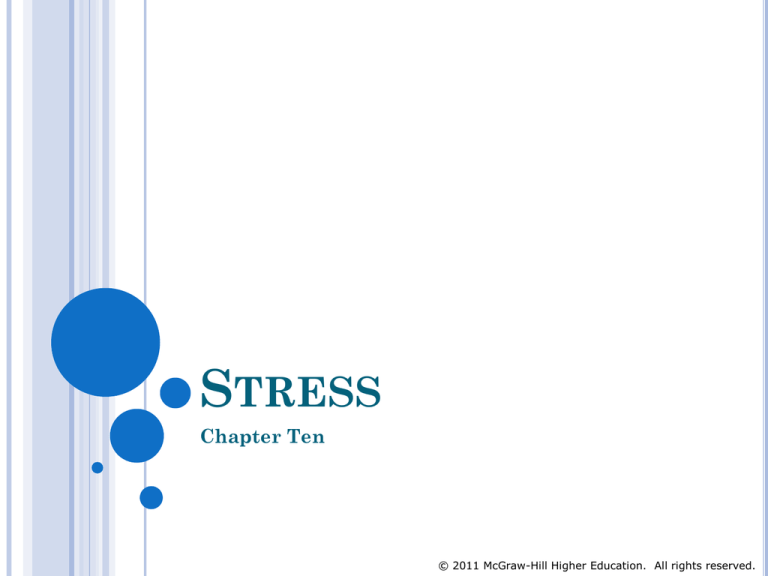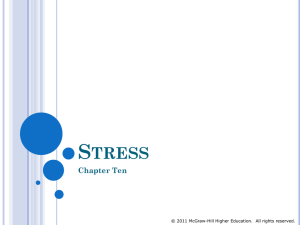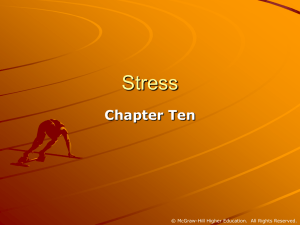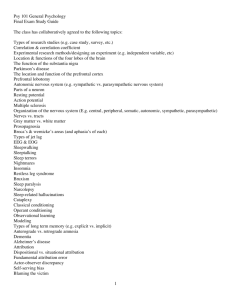
STRESS
Chapter Ten
© 2011 McGraw-Hill Higher Education. All rights reserved.
WHAT IS STRESS?
A stressor is any physical or psychological event
or condition that produces stress
A stress response is the physiological changes
associated with stress
Stress is the collective physiological and
emotional responses to any stimulus that
disturbs an individual’s homeostasis
2
© 2011 McGraw-Hill Higher Education. All rights reserved.
ACTIONS OF THE NERVOUS SYSTEM
The
Nervous System consists of the brain,
spinal cord, and nerves
The autonomic nervous system is the branch of the nervous
system that controls basic body processes, both sympathetic
and parasympathetic divisions
The sympathetic division is the division of the autonomic
nervous system that reacts to danger or other challenges by
accelerating body processes
Neurotransmitter - norepinephrine
The parasympathetic division is the division of the autonomic
nervous system that moderates the excitatory effect of the
sympathetic division by slowing things down
3
© 2011 McGraw-Hill Higher Education. All rights reserved.
ACTIONS OF THE ENDOCRINE SYSTEM
The endocrine system consists of glands, tissues, and cells that
secrete hormones into the bloodstream and influences
metabolism and body processes
The key chemical messengers or hormones involved are:
Norepinephrine: a neurotransmitter released by the
sympathetic division to increase body functions, increases
attention, awareness, alertness
Epinephrine: a hormone secreted by the inner core of the
adrenal gland also known as adrenalin
Cortisol: a steroid hormone secreted by the outer layer of the
adrenal gland, also known as hydrocortisone
Endorphins: brain secretions that have pain-inhibiting effects
4
© 2011 McGraw-Hill Higher Education. All rights reserved.
HOW THE TWO SYSTEMS WORK
TOGETHER
Together, the nervous system and the endocrine
system prepare the body to respond to a stressor
Key hormones, such as cortisol and epinephrine trigger
a “fight or flight reaction”
Once a stressful situation ends, the parasympathetic
division of the autonomic system returns the body to
homeostasis—a state of stability and consistency in
the person’s physiological functioning
The use of the “fight or flight” reaction in modern life
is often inappropriate, leading to impairment of one’s
emotional and physical health
5
© 2011 McGraw-Hill Higher Education. All rights reserved.
FIGURE 10.1 THE FIGHT-OR-FLIGHT
REACTION
6
© 2011 McGraw-Hill Higher Education. All rights reserved.
EMOTIONAL AND BEHAVIORAL
RESPONSES TO STRESSORS
Responses to stress may include anxiety, depression, and
fear, which will vary in intensity from person to person
Behavioral responses are controlled by the somatic nervous
system, which manages our conscious actions under our
control
What influences how we respond to stress emotionally and
behaviorally:
Personality traits
Type A: Higher perceived stress level and more problems
coping
Type B: Less frustrated by daily events and more tolerant
Type C: Suppression of anger, difficulty expressing emotions
Hardy personality
Past experiences
7
Gender
© 2011 McGraw-Hill Higher Education. All rights reserved.
THE GENERAL ADAPTATION
SYNDROME (GAS)
The GAS is a predictable response pattern (Seyle, 1930) to all
stressors
Hans Seyle recognized that stressors could be pleasant (eustress)
or unpleasant (distress)
The sequence follows 3 particular stages:
Alarm: fight of flight stage
Resistance: coping stage
Exhaustion: life threatening breakdown stage
Figure 10.3
8
© 2011 McGraw-Hill Higher Education. All Rights Reserved.
EFFECTS OF THE STRESS
RESPONSE
Allostatic load is the long-term negative impact of the
stress response on the body, especially long-term
exposure to stress hormones like cortisol
High allostatic load increases susceptibility to heart
disease, hypertension, obesity, and reduced brain
and immune function
Psychoneuroimmunology (PNI) is the study of the
interactions among the nervous system, the endocrine
system, and the immune system to stress responses
9
© 2011 McGraw-Hill Higher Education. All rights reserved.
LINKS BETWEEN STRESS AND SPECIFIC
CONDITIONS
Cardiovascular disease
Altered functioning of the immune system
Other health problems such as:
Digestive
Headaches
Insomnia
Injuries
Female reproductive issues
Psychological
10
© 2011 McGraw-Hill Higher Education. All rights reserved.
COMMON SOURCES OF STRESS
Major life changes
Daily hassles
College stressors
Academic stress
Interpersonal stress
Time pressures
Financial concerns
Worries about the future
Job-related stressors
Interpersonal and social
stressors
Environmental stressors
Physical and emotional
status
11
© 2011 McGraw-Hill Higher Education. All rights reserved.
MANAGING STRESS
Exercise
Nutrition
Sleep
Social support
Communication
Spiritual wellness
concepts
Journaling/Diary
Time management
Cognitive techniques
Relaxation techniques
Deep breathing
Progressive relaxation
Biofeedback
Hypnosis and selfhypnosis
Massage
12
© 2011 McGraw-Hill Higher Education. All rights reserved.
MANAGING STRESS: TIME MANAGEMENT
Set priorities
Schedule tasks for peak
efficiency
Set realistic goals
Budget enough time
Break up long-term goals
Visualize achievement of
goals
Track tasks you put off
Do the least favorite tasks first
Consolidate tasks
Identify transitional tasks
Delegate responsibility
Say no when necessary
Give yourself a break
Avoid personal time sinks
Just do it
13
© 2011 McGraw-Hill Higher Education. All rights reserved.
GETTING HELP
Peer Counseling and Support Groups
Professional Help
Psychotherapy
Is It Stress or Something More Serious?
Depression: a mood disorder characterized by loss of interest in
usual activities, sadness, hopelessness, loss of appetite, disturbed
sleep, and other physical symptoms
Depression is linked to suicide, one of the leading causes of death
among college students.
14
© 2011 McGraw-Hill Higher Education. All rights reserved.
STRESS
Chapter Ten









